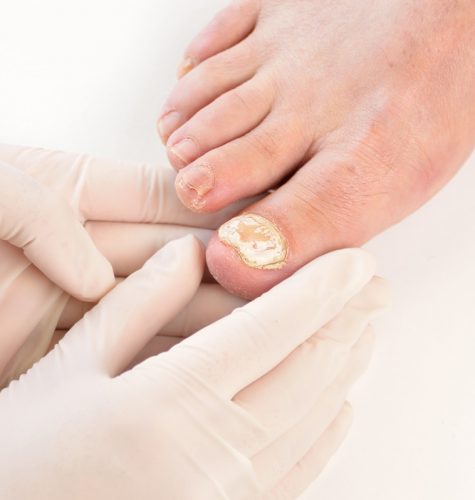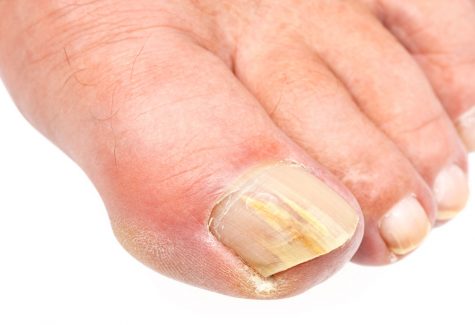What is Toenail Fungus?
Toenail Fungus, or onychomycosis, is often ignored because the infection can be present for years without causing any pain. The disease is characterized by a progressive change in a toenail’s quality and color, which is often ugly and embarrassing. In reality, the condition is an infection underneath the surface of the nail caused by fungi.
When the tiny organisms take hold, the nail often becomes darker in color and foul-smelling. Debris may collect beneath the nail plate, white marks frequently appear on the nail plate, and the infection is capable of spreading to other toenails, the skin, or even the fingernails. If ignored, the infection can spread and possibly impair one’s ability to work or even walk. This happens because the resulting thicker nails are difficult to trim and make walking painful when wearing shoes. Onychomycosis can also be accompanied by a secondary bacterial or yeast infection in or about the nail plate.
Because it is difficult to avoid contact with microscopic organisms like fungi, the toenails are especially vulnerable around damp areas where people are likely to be walking barefoot, such as swimming pools, locker rooms, and showers, for example. Injury to the nail bed may make it more susceptible to all types of infection, including fungal infection. Those who suffer from chronic diseases, such as diabetes, circulatory problems, or immune-deficiency conditions, are especially prone to fungal nails. Other contributing factors may be a history of athlete’s foot and excessive perspiration.


What is Toenail Fungus?
Toenail Fungus, or onychomycosis, is often ignored because the infection can be present for years without causing any pain. The disease is characterized by a progressive change in a toenail’s quality and color, which is often ugly and embarrassing. In reality, the condition is an infection underneath the surface of the nail caused by fungi.
When the tiny organisms take hold, the nail often becomes darker in color and foul-smelling. Debris may collect beneath the nail plate, white marks frequently appear on the nail plate, and the infection is capable of spreading to other toenails, the skin, or even the fingernails. If ignored, the infection can spread and possibly impair one’s ability to work or even walk. This happens because the resulting thicker nails are difficult to trim and make walking painful when wearing shoes. Onychomycosis can also be accompanied by a secondary bacterial or yeast infection in or about the nail plate.
Because it is difficult to avoid contact with microscopic organisms like fungi, the toenails are especially vulnerable around damp areas where people are likely to be walking barefoot, such as swimming pools, locker rooms, and showers, for example. Injury to the nail bed may make it more susceptible to all types of infection, including fungal infection. Those who suffer from chronic diseases, such as diabetes, circulatory problems, or immune-deficiency conditions, are especially prone to fungal nails. Other contributing factors may be a history of athlete’s foot and excessive perspiration.

Prevention
- Proper hygiene and regular inspection of the feet and toes are the first lines of defense against fungal nails
- Clean and dry feet resist disease
- Washing the feet with soap and water, remembering to dry thoroughly, is the best way to prevent an infection
- Shower shoes should be worn when possible in public areas
- Shoes, socks, or hosiery should be changed more than once daily
- Toenails should be clipped straight across so that the nail does not extend beyond the tip of the toe
- Wear shoes that fit well and are made of materials that breathe
- Avoid wearing excessively tight hosiery, which promote moisture
- Socks made of synthetic fiber tend to “wick” away moisture faster than cotton or wool socks
- Disinfect instruments used to cut nails
- Disinfect home pedicure tools
- Don’t apply polish to nails suspected of infection—those that are red, discolored, or swollen, for example
Prevention
- Proper hygiene and regular inspection of the feet and toes are the first lines of defense against fungal nails
- Clean and dry feet resist disease
- Washing the feet with soap and water, remembering to dry thoroughly, is the best way to prevent an infection
- Shower shoes should be worn when possible in public areas
- Shoes, socks, or hosiery should be changed more than once daily
- Toenails should be clipped straight across so that the nail does not extend beyond the tip of the toe
- Wear shoes that fit well and are made of materials that breathe
- Avoid wearing excessively tight hosiery, which promote moisture
- Socks made of synthetic fiber tend to “wick” away moisture faster than cotton or wool socks
- Disinfect instruments used to cut nails
- Disinfect home pedicure tools
- Don’t apply polish to nails suspected of infection—those that are red, discolored, or swollen, for example
Treatment of Fungal Nails
Treatments may vary, depending on the nature and severity of the infection. A daily routine of cleansing over a period of many months may temporarily suppress mild infections. White markings that appear on the surface of the nail can be filed off, followed by the application of an over-the-counter liquid antifungal agent. However, even the best over-the-counter treatments may not prevent a fungal infection from coming back.
A podiatric physician can detect a fungal infection early, culture the nail, determine the cause, and form a suitable treatment plan, which may include prescribing topical or oral medication, and debridement (removal of diseased nail matter and debris) of an infected nail.
Newer oral antifungals, approved by the Food and Drug Administration, may be the most effective treatment. They offer a shorter treatment regimen of approximately three months and improved effectiveness. Podiatrists may also prescribe a topical treatment for onychomycosis, which can be an effective treatment modality for fungal nails.
In some cases, surgical treatment may be required. Temporary removal of the infected nail can be performed to permit direct application of a topical antifungal. Permanent removal of a chronically painful nail, which has not responded to any other treatment, permits the fungal infection to be cured and prevents the return of a deformed nail.
Trying to solve the infection without the qualified help of a podiatric physician can lead to more problems. With new technical advances in combination with simple preventive measures, the treatment of these lightly regarded health problems can often be successful.
Your podiatric physician/surgeon has been trained specifically and extensively in the diagnosis and treatment of all manners of foot conditions. This training encompasses all of the intricately related systems and structures of the foot and lower leg including neurological, circulatory, skin, and the musculoskeletal system, which includes bones, joints, ligaments, tendons, muscles, and nerves.
Treatment of Fungal Nails
Treatments may vary, depending on the nature and severity of the infection. A daily routine of cleansing over a period of many months may temporarily suppress mild infections. White markings that appear on the surface of the nail can be filed off, followed by the application of an over-the-counter liquid antifungal agent. However, even the best over-the-counter treatments may not prevent a fungal infection from coming back.
A podiatric physician can detect a fungal infection early, culture the nail, determine the cause, and form a suitable treatment plan, which may include prescribing topical or oral medication, and debridement (removal of diseased nail matter and debris) of an infected nail.
Newer oral antifungals, approved by the Food and Drug Administration, may be the most effective treatment. They offer a shorter treatment regimen of approximately three months and improved effectiveness. Podiatrists may also prescribe a topical treatment for onychomycosis, which can be an effective treatment modality for fungal nails.
In some cases, surgical treatment may be required. Temporary removal of the infected nail can be performed to permit direct application of a topical antifungal. Permanent removal of a chronically painful nail, which has not responded to any other treatment, permits the fungal infection to be cured and prevents the return of a deformed nail.
Trying to solve the infection without the qualified help of a podiatric physician can lead to more problems. With new technical advances in combination with simple preventive measures, the treatment of these lightly regarded health problems can often be successful.
Your podiatric physician/surgeon has been trained specifically and extensively in the diagnosis and treatment of all manners of foot conditions. This training encompasses all of the intricately related systems and structures of the foot and lower leg including neurological, circulatory, skin, and the musculoskeletal system, which includes bones, joints, ligaments, tendons, muscles, and nerves.
